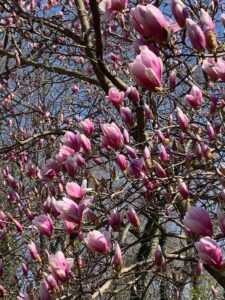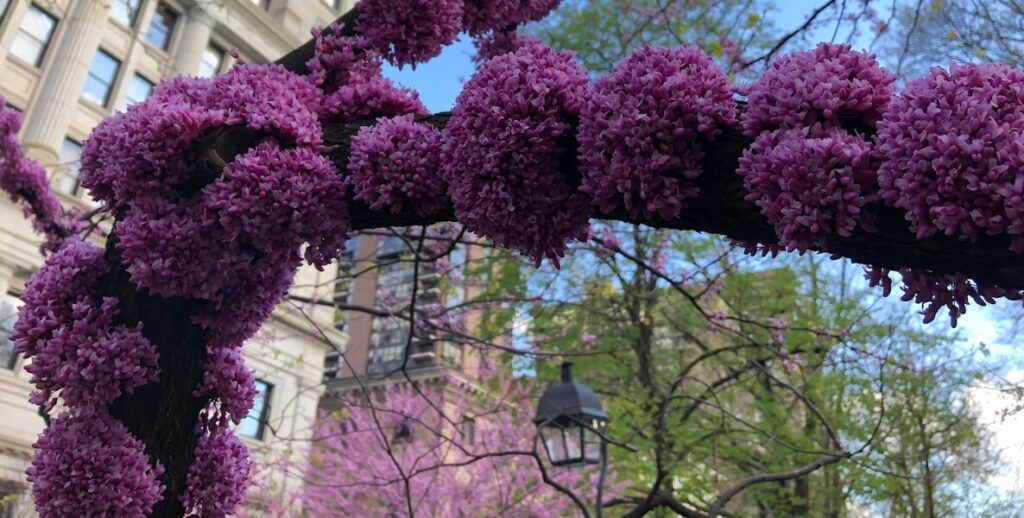You know that mint-like weed you’ve seen a zillion times in your neighbor’s front garden? It’s red deadnettle (Lamium purpureum), the young leaves of which make a tasty addition to a stir-fry.
Those trees in Washington Square, with hot-pink flowers growing all over the bark? They’re eastern redbuds, part of the same family as peas (legumes), whose unopened buds can be pickled and used as a substitute for capers.
The vibrant bushy green leaves first to appear from the brown forest floor in March? That’s skunk cabbage, and its flowers are thermogenic. Due to some magic in their mitochondria, they can actually produce heat and melt snow, attracting pollinators and giving the plant a headstart against competitors.
“There are all these interesting things about the natural word that are just so cool,” says Heather Zimmerman, program director of Philly’s Awbury Arboretum. “I think when people start learning, they want to know more.”
Luckily, there’s an app for that: iNaturalist, which makes it ridiculously easy to learn about the natural world around us, while generating useful data for scientists. And during this weekend’s BioBlitz, you can also use the app to make a quantifiable impact on science.
“The more interested people are in the environment, the better that we will take care of it,” says Zimmerman, “And the more people are outside, the better nature takes care of them.”
BioBlitz, a four-day global communal effort to record different species of plants and animals, is part of the City Nature Challenge, which, pre-Covid-19, was intended to be a competition among world cities to contribute the greatest number of observations and identify the greatest number of species.

The organizers announced mid-March that the challenge would no longer be a competition and encouraged folks to participate individually and safely. They didn’t cancel it in part because, at a time when we are deprived of socializing with other humans and are spending too much time indoors staring at screens, taking solace in nature is more helpful than ever.
Philly joined the challenge for the first time this year, supported by more than 40 partner organizations like Philadelphia Parks & Recreation, Clean Air Council, Friends of the Wissahickon, Laurel Hill Cemetery and Awbury Arboretum.
![]()
“People want to make a difference for the Earth regarding climate change and other stresses,” says Zimmerman, “But it’s kind of hard in your everyday life to know how to connect with that.”
Whether you can safely get to the woods, a city park, or are stuck exploring in and around your home, you can find naturally-occurring (no pets, and no human-cultivated/potted plants) living organisms and participate.
Here’s how it works:
- Find a wild plant or organism and take a closeup, clear photo by tapping ‘Observe’ in the app. When you tap ‘View Suggestions,’ iNaturalist’s AI search will offer possible identifications based on your photo and location. You can click through and read about each species, look at additional photos and try to identify the organism.
- After you do your best to identify your observation, you can share your photo.
- Your photo is then included in a global database of when and where species are found. This data is shared with the Global Biodiversity Information Facility, which scientists use to study changes in our natural world caused by climate change and habitat modifications and the overall health of our ecosystems.
Last year, iNaturalist data was used to publish more than 225 scientific papers including Climate change threatens New Guinea’s biocultural heritage, Research Gaps and Challenges in the Conservation and Use of North American Wild Lettuce Germplasm, and Distribution, conservation status, and abiotic stress tolerance potential of wild cucurbits.
Last winter, a beachgoer in Santa Barbara uploaded a photo of a washed-up seven-foot fish that he thought was the giant sunfish, Mola mola. The iNaturalist community chimed in with comments. Several fish scientists were tagged and joined the conversation. After the photographer was asked to go back and take more detailed photos, an Australian scientist determined that the fish was actually the Mola tecta—which had only been documented in the Northern Hemisphere once before.
Of course, most observations are not quite that groundbreaking, but they’re all valuable.
“Having accurate records supports everything from the health and aesthetics of the landscape to how we may wisely spend funds,” says Zimmerman of the value of documenting species at Awbury Arboretum.
You can help record species at the Arboretum—though all offices are closed, the grounds are open daily from sunrise to sunset for free, and there’s plenty of room to maintain a safe distance.
“Even on your block, whatever’s growing up out of the sidewalk, is still a species of something surviving and making its home,” says Zimmerman. “Nature is available to you wherever you are in some small degree.”
Or you can participate from anywhere in Philadelphia, including your neighborhood park, or even your home (where you—or your kids—can hunt for the 90 different species of insects found in most houses).
“Even on your block, whatever’s growing up out of the sidewalk, is still a species of something surviving and making its home,” says Zimmerman. “Nature is available to you wherever you are in some small degree.”
And it’s also comforting. The sensory stimulation of feeling the sun and the wind, hearing birds chirping, seeing plants’ vibrant colors causes us to experience pleasure, says horticultural therapist Nancy Minich. And taking time to notice spring is helpful, too.
“Take a walk and stop and look at the bark or look at the buds and then go back the next day and see the progress of something, how it opens up or how it changes overnight,” she says. At a time when all the days are blurring together, “seasonal changes are very important—they orient us.”
And as we learn about the natural world—starting in our own city—we start to form a relationship with the habitat and ecosystem that sustains our lives.
“The more interested people are in the environment, the better that we will take care of it,” says Zimmerman, “And the more people are outside, the better nature takes care of them.”

